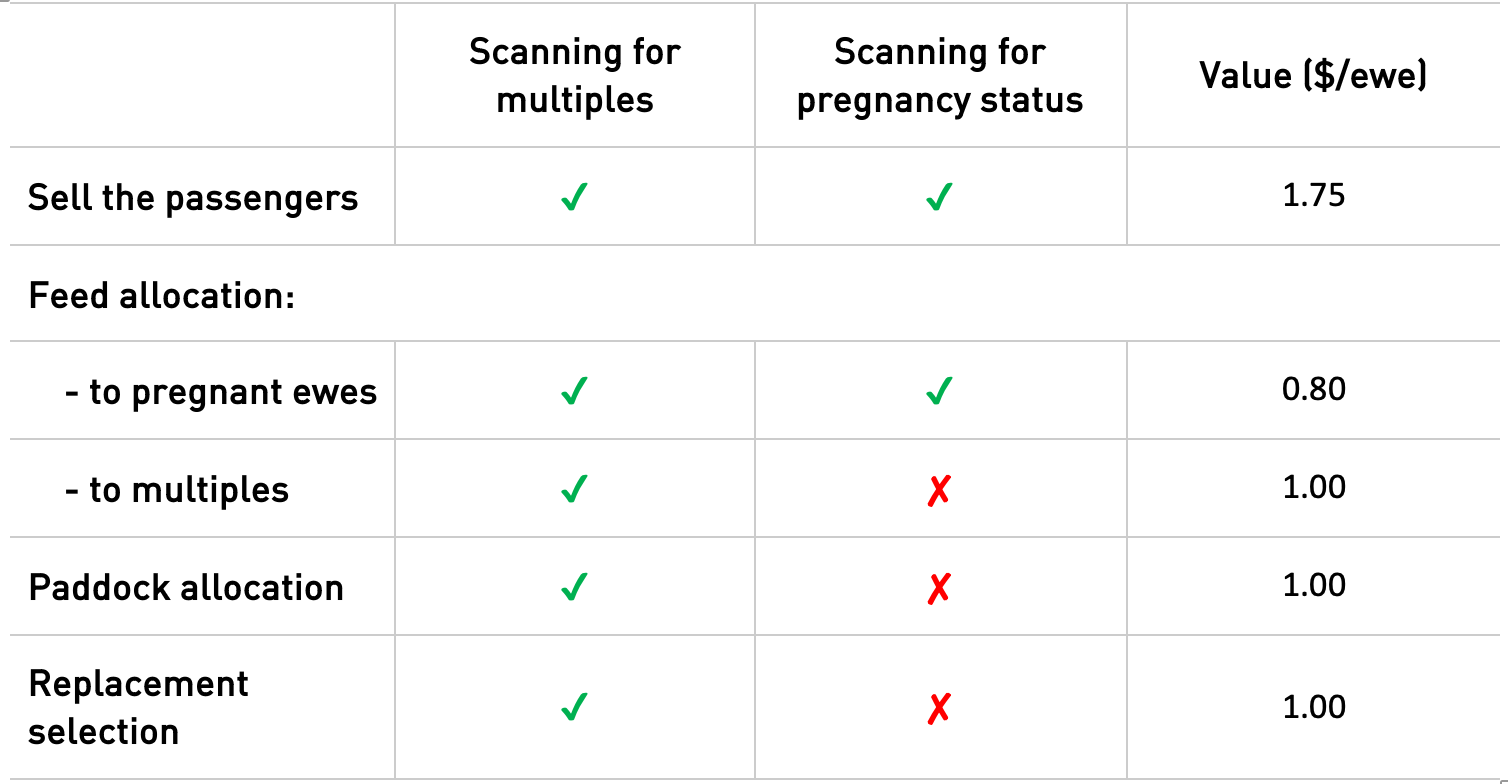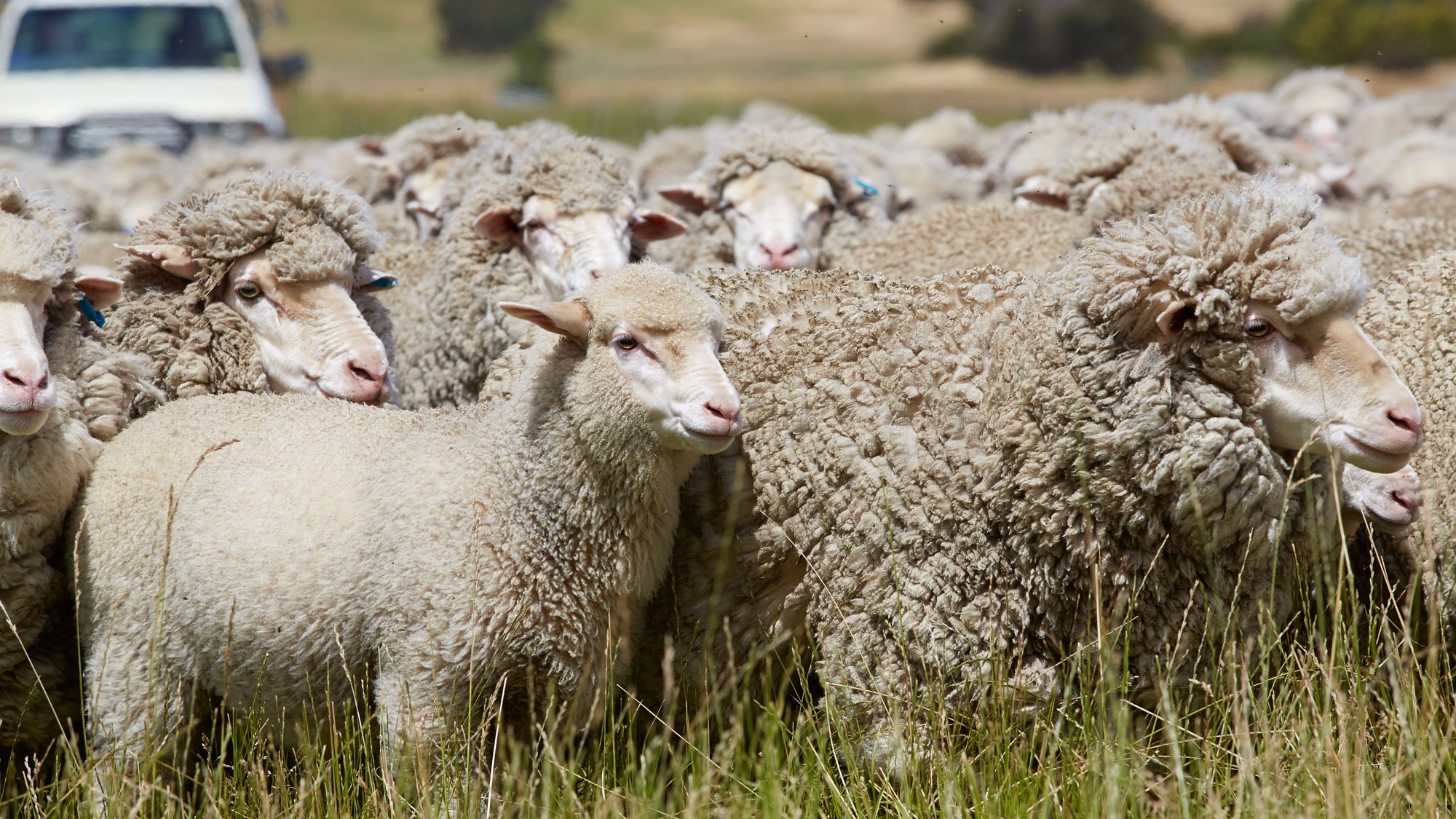Tool 10.8 Pregnancy scanning ewes
Pregnancy scanning ewes
Cost-benefit of scanning
Scanning for litter size and implementing optimal management of each group increases profitability by an average of $5.55 per ewe scanned, representing a 400% return on investment. Scanning for litter size is profitable across all breeds, growing seasons and times of lambing. Scanning for only pregnancy status is profitable in most scenarios and is about half as profitable as scanning for litter size, averaging $2.65 per ewe.
Table 10.2 The increase in farm profit ($ per ewe scanned) from scanning for multiples and implementing optimal management for four regions, three flock types and three times of lambing.
Source: AWI and MLA
|
|
Time of Lambing |
||
|
|
Autumn |
Winter |
Spring |
|
|
($/ewe) |
($/ewe) |
($/ewe) |
|
Winter rainfall region: high rainfall zone |
|||
|
Merino |
7.20 |
10.60 |
3.80 |
|
Merino – Terminal Sire |
6.40 |
8.80 |
6.00 |
|
Maternal |
7.50 |
8.80 |
5.40 |
|
Winter rainfall region: medium rainfall zone |
|||
|
Merino |
7.80 |
2.80 |
5.50 |
|
Merino – Terminal Sire |
9.80 |
5.20 |
3.70 |
|
Maternal |
5.80 |
4.00 |
4.20 |
|
Winter rainfall region: low rainfall zone |
|||
|
Merino |
4.60 |
4.60 |
1.20 |
|
Merino – Terminal Sire |
5.20 |
4.70 |
1.90 |
|
Maternal |
8.40 |
3.50 |
6.50 |
|
Summer rainfall region: high rainfall zone |
|||
|
Merino |
|
|
3.85 |
|
Merino – Terminal Sire |
|
7.52 |
7.06 |
|
Maternal |
2.01 |
1.74 |
|
|
|
|
|
|
|
Overall average |
$5.55 |
||
Table 10.3 The increase in farm profit ($ per ewe scanned) from scanning for pregnancy status only and implementing optimal management of the dry ewes for four regions, three flock types and three times of lambing.
Source: AWI and MLA
|
|
Time of Lambing |
||
|
|
Autumn |
Winter |
Spring |
|
|
($/ewe) |
($/ewe) |
($/ewe) |
|
Winter rainfall region: high rainfall zone |
|||
|
Merino |
6.30 |
5.70 |
1.30 |
|
Merino – Terminal Sire |
5.20 |
4.10 |
0.00 |
|
Maternal |
7.10 |
7.20 |
2.90 |
|
Winter rainfall region: medium rainfall zone |
|||
|
Merino |
4.10 |
-1.50 |
1.50 |
|
Merino – Terminal Sire |
4.60 |
0.90 |
-1.50 |
|
Maternal |
4.80 |
3.00 |
0.90 |
|
Winter rainfall region: low rainfall zone |
|||
|
Merino |
2.50 |
1.20 |
-0.30 |
|
Merino – Terminal Sire |
2.00 |
1.00 |
-0.90 |
|
Maternal |
7.50 |
3.30 |
3.00 |
|
Summer rainfall region: high rainfall zone |
|||
|
Merino |
|
|
1.16 |
|
Merino – Terminal Sire |
|
1.86 |
1.78 |
|
Maternal |
1.64 |
1.57 |
|
|
|
|
|
|
|
Overall average |
$2.62 |
||
Management of scanned ewes
For pregnancy scanning to be profitable, ewes must be managed according to their pregnancy status (table 10.4). These management changes include selling passenger ewes, feed allocation, paddock allocation and selection of replacement ewes for birth type/rear type.
Table 10.4 The contribution of each management component to the value of scanning and whether that component is possible based on the level of scanning undertaken.
Source: AWI and MLA

Selling passenger ewes
- Selling ‘once dry’ ewes is more profitable for flocks that are able to self-replace. This is achievable when weaning rates are greater than 90%.
- Selling ‘twice dry’ ewes is recommended for flocks with lower weaning rates.
- The optimal time to sell is a trade-off between the extra feed available from selling empty ewes early and the income that is foregone from wool production. Selling at scanning is usually most profitable if scanning occurs prior to the main feed shortage.
Feed allocation
- If feed is not allocated according to pregnancy status, empty ewes will typically be 0.5 CS higher than single bearing ewes at lambing, and twin bearing ewes will be 0.5 CS lower.
- If ewes are scanned for litter size, any retained empty ewes should be 0.5 to 1.0 CS lower than single bearing ewes at lambing, and twin bearing ewes should be 0.3 to 0.5 CS higher.
Paddock allocation
- Better quality lambing paddocks with greater levels of shelter should be allocated to multiple-bearing ewes.
Replacement selection
- Identify twin born progeny to select replacement ewes based on birth type.
- It is expected that selecting for twin born progeny will increase profitability in the long term. This is particularly true for meat production.
- If twin born progeny are not identified, they will be selected against because they are smaller than single born progeny.
Effect of reproductive rate on the value of scanning
The total value of scanning is not sensitive to the reproductive rate of the flock provided that the flock can remain self-replacing when twice-empty ewes are sold. Reproductive rate does, however, affect the relative contribution of different management practices to the value of scanning (figure 10.9).

Figure 10.9 The value of pregnancy scanning for multiples is not sensitive to the reproductive rate of the flock, although the contribution from managing the ewes scanned empty or managing the multiple bearing ewes changes across the range.
Source: AWI and MLA
Key considerations for interpreting the value of pregnancy scanning differ depending on your production goals and environment, but the main points to note are:
- The reproductive rate of the flock has a minimal effect on the overall value of scanning for litter size.
- At lower reproductive rates, managing scanned empty ewes contributes more to the value of scanning than managing multiple ewes does.
- At higher reproductive rates, managing multiple bearing ewes contributes more to the value of scanning than managing empty ewes does.
- The differential management of multiple-bearing ewes through optimum feed and paddock allocation is profitable across all reproductive rates. It is an important tool for increasing the health and welfare of both lambs and ewes.






